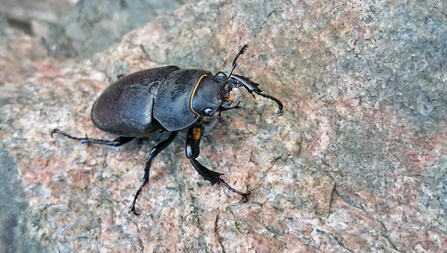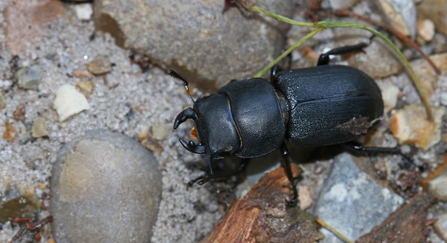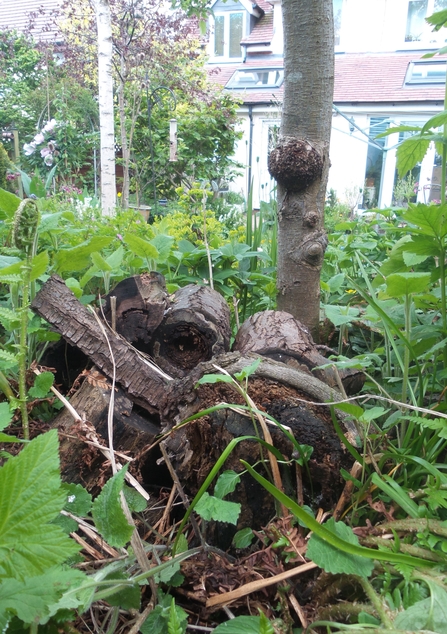Beetles aren't everyone's cup of tea. I remember being repulsed by their scuttling when I was little but I don't really know why because, at the same age, I couldn't wait to let spiders crawl on my hand if I saw one. There are over 4000 species of beetle in the UK and they come in all shapes, colours and sizes from the childhood favourites of ladybirds to the breath-holding diving beetles. No beetle that trundles on our pavements, however, comes bigger than a stag beetle...and these days I go looking for them instead of running in the opposite direction.
Stag party
Stag beetles by Terry Whittaker/2020VISION

Female stag beetle by Wendy Carter
With the males large 'antlers', stag beetles can grow up to 10cm in length. They get their name from the antler-like jaws (mandibles) that the males sport in order to fight for the attentions of female beetles. Females are lacking those apparently unwieldy weapons but can give you quite the nip if they feel threatened. Both sexes can be identified by their shiny black head and thorax (mid section of their body) with chestnut brown to black wing cases. Females are most easily confused with lesser stag beetles but the latter have a black body with dimples on both the thorax and wing cases. In stag beetles, the wing cases 'bulge out' to be wider than the thorax whereas in lesser stag beetles, the wing cases are parallel-sided.

Lesser stag beetle by Wendy Carter
Stag beetles are a globally threatened species (and have limited legal protection in the UK) and, although Worcestershire is at the northern edge of their UK range, the town of Upton-upon-Severn and its surrounding villages are a hotspot for them.
What's been going wrong for our friendly beetle giants? Habitat decline is the most obvious problem. Females lay their eggs into decaying wood and this important habitat needs to be available above and below ground as well as there for a long time because it takes up to seven years for the larvae to develop into an adult. In our increasingly tidy society, however, we like to remove these 'messy' habitats from our gardens, parks and woodlands. This isn't a problem just for our stag beetles - dead trees and wood provide homes for many other invertebrates as well as roosts for bats and birds.
Suburban stag beetles also suffer from increased traffic - both feet and wheels. Next time the sun shines, bend down and touch the pavement or a patio and you'll find that it's soaking up the rays (especially dark tarmac) and this provides a wonderfully warm spot for a large beetle to gather energy to take off and fly. They're not as nimble at moving out of the way of our feet or wheels, though, and it's sad to wander the streets of Upton to see a few squashed on warm evenings. Cats, foxes and other predators also take their toll on the population - adults only live for 40 days or so, which isn't very long when there are so many perils in the world!

Log pile in garden by Gary Farmer
Whether we have stag beetles in our area or not, what helps stag beetles will help other wildlife. So what can we all do? If you've got the space (or can chat to your neighbours or local green space owners), leaving a pile of fallen wood - particularly oak or beech - in a corner of your garden, school wildlife area or other green space would be a start. Even better is if you can dig a hole and sink some of it into the soil - about 60cm deep should do the trick. This will help other species too. If you fell a tree, leave the stump in the ground.
If you see stag beetles in a natural area, please don't disturb them. If one has fallen on its back then by all means, help it to get the right way up and move it to a safer place if it's in other danger. Even doing something as simple as covering any water butts so that beetles don't fall into them will make a difference.
It's been an odd spring so far but if the weather warms up, as we all hope that it will, June and July are the perfect time to spot stag beetles. Wait for a day that's been hot and has one of those lovely summer evenings that make you feel that you've been transported to a much warmer place than the UK (!), then keep a look out near dead wood and on warm pavements in or around Upton-upon-Severn. I might see you there!
If you are lucky enough to spot a stag beetle in Worcestershire, we'd love to know about it. Please snap a photo and let us know via our short wildlife sightings form (tick the 'other' box).

